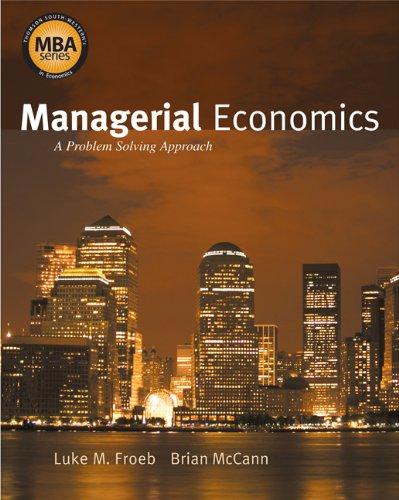Question
In August 2014, Tesla announced a new Infinite Mile Warranty. A Forbes article reported: Tesla announced that it would extend the warranty on the drive
In August 2014, Tesla announced a new "Infinite Mile Warranty". A Forbes article reported: "Tesla
announced that it would extend the warranty on the drive unit of its Model S cars to match the battery
pack's 8 years and unlimited miles with no limit on the number of owners. This will apply to new Model
S models and all ever produced." (Chuck Jones, Forbes, Aug 18, 2014)
(a) Suppose that without the new warranty, demand for Tesla's model S car is given by:
P = 200 2Q, where P is in thousands of dollars per car, and Q is in thousands of cars. Suppose
that prior to the new warranty, marginal cost of production was constant at 32 thousand dollars
per car.
Based on these assumptions, what is profit maximizing price per car for Tesla without the new
warranty? What quantity is sold? What is the producer surplus from sale of the model S? Fill in
your answers in the box below and explain using a clearly labelled illustration.
Price (in thousands of $ per car) =
Quantity (in thousand) =
Surplus (in $ millions) =
(b) Suppose that offering the eight year, unlimited mileage warranty increases willingness
to pay for each potential customer by 10 thousand dollars, so that the inverse demand curve shifts
up vertically by 10 thousand dollars.
Assume also that the cost of offering the warranty varies with mileage accrued by customers, at a
rate of $1 thousand per ten thousand miles. Tesla's estimates show that the average customer of
their Model S would drive about 60 thousand miles in eight years. So all-in-all the expected cost
to Tesla of the extended warranty is $6 thousand per car.
Assume there are no other additional costs involved with offering the extended warranty, and that
Tesla is risk neutral.
Would Tesla's surplus increase, decrease, or remain the same if they offered the warranty? What
would be the amount of the change in surplus? Explain.
Surplus would: Increase, Decrease, Remain the same?
Change in surplus (in $ millions) =
(c) Recent articles suggest that Tesla's extended warranty may be costing the company
more than anticipated. An article in October 2017 on Seeking Alpha noted that in particular,
taxi and ride sharing service drivers are buying the model S, attracted by the unlimited mileage
warranty.
Suppose that, due to larger than expected purchases by higher mileage owners, Tesla revises its
estimate of the mileage usually driven during the eight year warranty period to 120,000 miles (up
from 60,000 miles). Suppose that demand, the cost of the warranty per thousand miles, and all
other costs stay the same as in part (b) above.
Under the revised cost assumptions would Tesla's surplus increase or decrease or remain the same
if they offered the warranty compared to if they didn't? Explain.
Surplus would: Increase, Decrease, Remain the same?
(d) An estimate by the American Lung Association suggests that the health costs associated
with burning a gallon of gasoline in cars is $1.30. Suppose that the gas mileage of the average car
replaced by the Tesla S is 30 miles per gallon, and suppose that the Tesla S (which uses no gas
at all) is driven an average of 150,000 miles over its lifetime.
It's not all good news: producing the electricity to charge Teslas produces pollution. Suppose that
producing the necessary electricity to charge a Tesla imposes a cost on society equal to $0.01 per
mile driven by the Tesla.
Given these estimates, does the sale and use of each Tesla overall produce a positive or negative
externality? What is the amount of the externality? (Hint: There's a trade-off here; Teslas don't
use gas, but they the charging stations do create pollution. You can also ignore discounting. Do
not make any other assumptions than what is given here.) As a result, relative to the social
optimum, what can we say about the quantity of Tesla S's sold in the market?
Overall externality is: Negative, Positive,Zero?
Overall amount of externality per Tesla =
Relative to the
Step by Step Solution
There are 3 Steps involved in it
Step: 1

Get Instant Access to Expert-Tailored Solutions
See step-by-step solutions with expert insights and AI powered tools for academic success
Step: 2

Step: 3

Ace Your Homework with AI
Get the answers you need in no time with our AI-driven, step-by-step assistance
Get Started


